RETRACTED: A Study on Life Cycle Impact Assessment of Seawater Desalination Systems: Seawater Reverse Osmosis Integrated with Bipolar-Membrane-Enhanced Electro-Dialysis Process
Abstract
:1. Introduction
2. Related Work
3. Materials and Methods
3.1. Multi-Stage Flash (MSF) Desalination Process
3.2. Seawater Reverse Osmosis (SWRO) Process
3.3. Integration of Electrodialysis with Bipolar Membranes (EDBM)
4. Life Cycle Impact Assessment (LCIA) Framework
5. LCIA of EDBM Integrated with SWRO Desalination System
5.1. Description of the System and the Functional Unit
- The desalination plant’s infrastructural details such as construction and dismantling are not considered in the LCIA analysis.
- The stage(s) of transportation regarding the reagents both into and out of the desalination plant have not been considered in the structural limitations of the LCA.
- An overall electrical energy consumption by the SWRO plant of approximately 3.0 kWh/m3 of desalted seawater has been assumed [80]. Therefore, assuming 50.0% freshwater production using the SWRO desalination system [32], an electrical energy consumption of 6.0 kWh/m3 of freshwater production is considered, which comprises the (i) pre-treatment stage, (ii) a highly pressurized pumping stage, (iii) a selective membrane stage, the post-treatment stage, and (iv) cleaning of the membrane [2].
- The brine (NaCl) concentration is assumed to be 63.50 g/L of NaCl [75].
- The seawater concentration is assumed to be 31.80 g/L of brine (NaCl) [75].
- The EDBM plant’s energy consumption is assumed to be 4.40 kWh/kg of HCl reagent at a laboratory scale.
- The heat energy input required during the stages of concentration of acid (35.0% volume, i.e., HCl) and the base (dry product, i.e., NaOH) is estimated using the water’s latent vaporization heat of 2257.0 MJ/ton until the desired five purity levels. The CF in the case of steam is taken as 0.2940 kg CO2 equivalent kW/h.
- The density of seawater is approximated at 1000 kg/m3.
5.2. Life Cycle Inventory (LCI)
6. Results and Discussion
6.1. BD Scenarios
6.2. Life Cycle Interpretation of Outcomes
6.2.1. Impact on Climate Change
6.2.2. Impact on Global Warming Potential (GWP)
6.2.3. Relative Impact of Desalination System Components
6.3. Ecological Implications
7. Conclusions
Funding
Institutional Review Board Statement
Informed Consent Statement
Data Availability Statement
Acknowledgments
Conflicts of Interest
References
- Mekonnen, M.M.; Hoekstra, A.Y. Four billion people facing severe water scarcity. Sci. Adv. 2016, 2, e1500323. [Google Scholar] [CrossRef] [PubMed]
- Pal, M.; Ayele, Y.; Hadush, M.; Panigrahi, S.; Jadhav, V. Public health hazards due to unsafe drinking water. Air Water Borne Dis. 2018, 7, 2. [Google Scholar]
- Boretti, A.; Rosa, L. Reassessing the projections of the world water development report. NPJ Clean Water 2019, 2, 15. [Google Scholar] [CrossRef]
- Zhang, C.-Y.; Oki, T. Water pricing reform for sustainable water resources management in China’s agricultural sector. Agric. Water Manag. 2023, 275, 108045. [Google Scholar] [CrossRef]
- Dhal, L.; Swain, S. Understanding and modeling the process of seawater intrusion: A review. Adv. Remediat. Tech. Polluted Soils Groundw. 2022, 48, 269–290. [Google Scholar] [CrossRef]
- Sayed, E.T.; Olabi, A.; Elsaid, K.; Al Radi, M.; Alqadi, R.; Abdelkareem, M.A. Recent progress in renewable energy based-desalination in the Middle East and North Africa MENA region. J. Adv. Res. 2023, 48, 125–156. [Google Scholar] [CrossRef] [PubMed]
- Xu, X.; Ness, J.E.; Miara, A.; Sitterley, K.A.; Talmadge, M.; O’Neill, B.; Coughlin, K.; Akar, S.; Edirisooriya, E.T.; Kurup, P. Analysis of brackish water desalination for municipal uses: Case studies on challenges and opportunities. ACS EST Eng. 2022, 2, 306–322. [Google Scholar] [CrossRef]
- De Nicolás, A.P.; Molina-García, A.; Vera-García, F.; García-Bermejo, J.T. Sustainable Zero Liquid Discharge for Desalination and Denitrification Processes: Desirows Life European Project. In Proceedings of the 2022 IEEE International Conference on Environment and Electrical Engineering and 2022 IEEE Industrial and Commercial Power Systems Europe (EEEIC/I&CPS Europe), Prague, Czech Republic, 28 June–1 July 2022; pp. 1–5. [Google Scholar]
- Panagopoulos, A. Techno-economic assessment and feasibility study of a zero liquid discharge (ZLD) desalination hybrid system in the Eastern Mediterranean. Chem. Eng. Process. Process Intensif. 2022, 178, 109029. [Google Scholar] [CrossRef]
- Moossa, B.; Trivedi, P.; Saleem, H.; Zaidi, S.J. Desalination in the GCC countries—A review. J. Clean. Prod. 2022, 357, 131717. [Google Scholar] [CrossRef]
- Darwish, M.; Hassabou, A.H.; Shomar, B. Using Seawater Reverse Osmosis (SWRO) desalting system for less environmental impacts in Qatar. Desalination 2013, 309, 113–124. [Google Scholar] [CrossRef]
- Mannan, M.; Alhaj, M.; Mabrouk, A.N.; Al-Ghamdi, S.G. Examining the life-cycle environmental impacts of desalination: A case study in the State of Qatar. Desalination 2019, 452, 238–246. [Google Scholar] [CrossRef]
- Assad, M.E.H.; AlMallahi, M.N.; Abdelsalam, M.A.; AlShabi, M.; AlMallahi, W.N. Desalination technologies: Overview. In Proceedings of the 2022 Advances in Science and Engineering Technology International Conferences (ASET), Dubai, United Arab Emirates, 21–24 February 2022; pp. 1–4. [Google Scholar]
- Natarajan, S.K.; Suraparaju, S.K.; Elavarasan, R.M. A review on low-temperature thermal desalination approach. Environ. Sci. Pollut. Res. 2022, 29, 32443–32466. [Google Scholar] [CrossRef] [PubMed]
- Kumar, S.; Kumar, M.; Chowdhury, S.; Rajpurohit, B.S.; Randhawa, J.K. Environmental concerns and long-term solutions for solar-powered water desalination. J. Clean. Prod. 2022, 345, 131180. [Google Scholar] [CrossRef]
- Do Thi, H.T.; Tóth, A.J. Investigation of CFs of Three Desalination Technologies: Reverse Osmosis (RO), Multi-Stage Flash Distillation (MSF) and Multi-Effect Distillation (MED). Period. Polytech. Chem. Eng. 2023, 67, 41–48. [Google Scholar] [CrossRef]
- Tayefeh, M. An innovative rearrangement and comprehensive comparison of the combination of compressed air energy storage (CAES) with multi-stage flash (MSF) desalination and multi-effect distillation (MED) systems. J. Energy Storage 2022, 52, 105025. [Google Scholar] [CrossRef]
- Alhaj, M.; Mabrouk, A.; Al-Ghamdi, S.G. Energy efficient multi-effect distillation powered by a solar linear Fresnel collector. Energy Convers. Manag. 2018, 171, 576–586. [Google Scholar] [CrossRef]
- Najjar, E.; Al-Hindi, M.; Massoud, M.; Saad, W. Life cycle assessment and cost of a seawater reverse osmosis plant operated with different energy sources. Energy Convers. Manag. 2022, 268, 115964. [Google Scholar] [CrossRef]
- European Union. A Guide to Autonomous Desalination System Concepts. Brussels: European Union: European Union ADIRA Handbook; European Union: Geneva, Switzerland, 2008. [Google Scholar]
- Mabrouk, A.A.; Bourouni, K.; Abdulrahim, H.K.; Darwish, M.; Sharif, A. Impacts of tube bundle arrangement and feed flow pattern on the scale formation in large capacity MED desalination plants. Desalination 2015, 357, 275–285. [Google Scholar] [CrossRef]
- Maftouh, A.; El Fatni, O.; Bouzekri, S.; Rajabi, F.; Sillanpää, M.; Butt, M.H. Economic feasibility of solar-powered reverse osmosis water desalination: A comparative systemic review. Environ. Sci. Pollut. Res. 2023, 30, 2341–2354. [Google Scholar] [CrossRef]
- Small, M.J. Policy analysis at ES&T. Environ. Sci. Technol. 2012, 46, 2483. [Google Scholar]
- Al-Ghamdi, S.G.; Bilec, M.M. On-site renewable energy and green buildings: A system-level analysis. Environ. Sci. Technol. 2016, 50, 4606–4614. [Google Scholar] [CrossRef] [PubMed]
- Lave, L.B. Using input-output analysis to estimate economy-wide discharges. Environ. Sci. Technol. 1995, 29, 420A–426A. [Google Scholar] [CrossRef]
- Pacca, S.; Horvath, A. Greenhouse gas emissions from building and operating electric power plants in the Upper Colorado River Basin. Environ. Sci. Technol. 2002, 36, 3194–3200. [Google Scholar] [CrossRef]
- Drioli, E.; Ali, A.; Macedonio, F. Membrane operations for process intensification in desalination. Appl. Sci. 2017, 7, 100. [Google Scholar] [CrossRef]
- Amy, G.; Ghaffour, N.; Li, Z.; Francis, L.; Linares, R.V.; Missimer, T.; Lattemann, S. Membrane-based seawater desalination: Present and future prospects. Desalination 2017, 401, 16–21. [Google Scholar] [CrossRef]
- Meneses, M.; Pasqualino, J.C.; Céspedes-Sánchez, R.; Castells, F. Alternatives for reducing the environmental impact of the main residue from a desalination plant. J. Ind. Ecol. 2010, 14, 512–527. [Google Scholar] [CrossRef]
- García-Rubio, M.A.; Guardiola, J. Desalination in Spain: A growing alternative for water supply. Int. J. Water Resour. Dev. 2012, 28, 171–186. [Google Scholar] [CrossRef]
- Palomar, P.; Losada, I.J. The impacts of desalination on the marine. In The Marine Environment: Ecology Management and Conservation; Nemeth, A.D., Ed.; Nova Science: New York, NY, USA, 2011. [Google Scholar]
- Fernández-Torquemada, Y.; Sánchez-Lizaso, J.L. Effects of salinity on leaf growth and survival of the Mediterranean seagrass Posidonia oceanica (L.). Delile. J. Exp. Mar. Biol. 2005, 320, 7–63. [Google Scholar] [CrossRef]
- Gacia, E.; Invers, O.; Manzanera, M.; Ballesteros, E.; Romero, J. Impact of the brine from a desalination plant on a shallow seagrass (Posidonia oceanica) meadow. Estuar. Coast. Shelf Sci. 2007, 72, 579–590. [Google Scholar] [CrossRef]
- Del-Pilar-Ruso, Y.; De-la-Ossa-Carretero, J.A.; Giménez-Casalduero, F.; Sánchez-Lizaso, J.L. Effects of a brine discharge over soft bottom Polychaeta assemblage. Environ. Pollut. 2008, 156, 240–250. [Google Scholar] [CrossRef]
- Sánchez-Lizaso, J.L.; Romero, J.; Ruiz, J.; Gacia, E.; Buceta, J.L.; Invers, O.; Torquemada, Y.F.; Mas, J.; Ruiz-Mateo, A.; Manzanera, M. Salinity tolerance of the Mediterranean seagrass Posidonia oceanica: Recommendations to minimize the impact of brine discharges from desalination plants. Desalination 2008, 221, 602–607. [Google Scholar] [CrossRef]
- Roberts, D.A.; Johnston, E.L.; Knott, N.A. Impacts of desalination plant discharges on the marine environment: A critical review of published studies. Water Res. 2010, 44, 5117–5128. [Google Scholar] [CrossRef]
- Yoon, S.J.; Park, G.S. Ecotoxicological effects of brine discharge on the marine community by seawater desalination. Desalin. Water Treat. 2011, 33, 240–247. [Google Scholar] [CrossRef]
- Belkin, N.; Rahav, E.; Elifantz, H.; Kress, N.; Berman-Frank, I. Enhanced salinities, as a proxy of seawater desalination discharges, impact coastal microbial communities of the eastern Mediterranean Sea. Environ. Microbiol. 2015, 17, 4105–4120. [Google Scholar] [CrossRef] [PubMed]
- Belkin, N.; Rahav, E.; Elifantz, H.; Kress, N.; Berman-Frank, I. The effect of coagulants and antiscalants discharged with seawater desalination brines on coastal microbial communities: A laboratory and in situ study from the southeastern Mediterranean. Water Res. 2017, 110, 321–331. [Google Scholar] [CrossRef] [PubMed]
- de-la-Ossa-Carretero, J.A.; Del-Pilar-Ruso, Y.; Loya-Fernández, A.; Ferrero-Vicente, L.M.; Marco-Méndez, C.; Martinez-Garcia, E.; Giménez-Casalduero, F.; Sánchez-Lizaso, J.L. Bioindicators as metrics for environmental monitoring of desalination plant discharges. Mar. Pollut. Bull. 2016, 103, 313–318. [Google Scholar] [CrossRef]
- Röthig, T.; Ochsenkühn, M.A.; Roik, A.; Van Der Merwe, R.; Voolstra, C.R. Long-term salinity tolerance is accompanied by a major restructuring of the coral bacterial microbiome. Mol. Ecol. 2016, 25, 1308–1323. [Google Scholar] [CrossRef]
- Jiang, C.; Wang, Y.; Wang, Q.; Feng, H.; Xu, T. Production of lithium hydroxide from lake brines through electro–electrodialysis with bipolar membranes (EEDBM). Ind. Eng. Chem. 2014, 53, 6103–6112. [Google Scholar] [CrossRef]
- Jiang, C.; Wang, Y.; Zhang, Z.; Xu, T. Electrodialysis of concentrated brine from RO plant to produce coarse salt and freshwater. J. Membr. Sci. 2014, 450, 323–330. [Google Scholar] [CrossRef]
- Ortiz-Albo, P.; Ibañez, R.; Urtiaga, A.; Ortiz, I. Phenomenological prediction of desalination brines nanofiltration through the indirect determination of zeta potential. Sep. Purif. Technol. 2019, 210, 746–753. [Google Scholar] [CrossRef]
- Koter, S.; Warszawski, A. A new model for characterization of bipolar membrane electrodialysis of brine. Desalination 2006, 198, 111–123. [Google Scholar] [CrossRef]
- Pérez-González, A.; Urtiaga, A.M.; Ibáñez, R.; Ortiz, I. State of the art and review on the treatment technologies of water reverse osmosis concentrates. Water Res. 2012, 46, 267–283. [Google Scholar] [CrossRef] [PubMed]
- Wang, M.; Wang, K.K.; Jia, Y.X.; Ren, Q.C. The reclamation of brine is generated from the desalination process by bipolar membrane electrodialysis. J. Membr. Sci. 2014, 452, 54–61. [Google Scholar] [CrossRef]
- Yang, Y.; Gao, X.; Fan, A.; Fu, L.; Gao, C. An innovative beneficial reuse of seawater concentrate using bipolar membrane electrodialysis. J. Membr. Sci. 2014, 449, 119–126. [Google Scholar] [CrossRef]
- Fernandez-Gonzalez, C.; Dominguez-Ramos, A.; Ibañez, R.; Irabien, A. Electrodialysis with bipolar membranes for valorization of brines. Sep. Purif. Rev. 2016, 45, 275–287. [Google Scholar] [CrossRef]
- Reig, M.; Valderrama, C.; Gibert, O.; Cortina, J.L. Selectrodialysis and bipolar membrane electrodialysis combination for industrial process brine treatment: Monovalent-divalent ions separation and acid and base production. Desalination 2016, 399, 88–95. [Google Scholar] [CrossRef]
- Masdar. Global CO2 Emissions of Water Desalination Plants. 2015. Available online: http://www.clca.columbia.edu/Global-Water.pdf (accessed on 10 September 2023).
- Shahabi, M.P.; McHugh, A.; Anda, M.; Ho, G. Environmental life cycle assessment of seawater reverse osmosis desalination plant powered by renewable energy. J. Renew. Energy 2014, 67, 53–58. [Google Scholar] [CrossRef]
- Siefan, A.; Rachid, E.; Elashwah, N.; AlMarzooqi, F.; Banat, F.; van der Merwe, R. Desalination via solar membrane distillation and conventional membrane distillation: Life cycle assessment case study in Jordan. Desalination 2022, 522, 115383. [Google Scholar] [CrossRef]
- Ghazi, Z.M.; Rizvi, S.W.F.; Shahid, W.M.; Abdulhameed, A.M.; Saleem, H.; Zaidi, S.J. An overview of water desalination systems integrated with renewable energy sources. Desalination 2022, 542, 116063. [Google Scholar] [CrossRef]
- Elhashimi, M.A.; Gee, M.; Abbasi, B. Unconventional desalination: The use of cyclone separators in HDH desalination to achieve zero liquid discharge. Desalination 2022, 539, 115932. [Google Scholar] [CrossRef]
- Cassaro, C.; Virruso, G.; Culcasi, A.; Cipollina, A.; Tamburini, A.; Micale, G. Electrodialysis with Bipolar Membranes for the Sustainable Production of Chemicals from Seawater Brines at Pilot Plant Scale. ACS Sustain. Chem. Eng. 2023, 11, 2989–3000. [Google Scholar] [CrossRef] [PubMed]
- Herrero-Gonzalez, M.; Ibañez, R. Technical and Environmental Feasibilities of the Commercial Production of NaOH from Brine by Means of an Integrated EDBM and Evaporation Process. Membranes 2022, 12, 885. [Google Scholar] [CrossRef]
- Ramesh, M.; Deepa, C.; Kumar, L.R.; Sanjay, M.; Siengchin, S. Life-cycle and environmental impact assessments on the processing of plant fibers and its bio-composites: A critical review. J. Ind. Text. 2022, 51, 5518S–5542S. [Google Scholar] [CrossRef]
- Moreno Leiva, S. Optimal Planning of Water and Renewable Energy Systems for Copper Production Processes with Sector Coupling and Demand Flexibility; Eigenverlag des Instituts für Wasser-und Umweltsystemmodellierung: Stuttgart, Germany, 2022. [Google Scholar]
- Ghyselbrecht, K.; Huygebaert, M.; Van der Bruggen, B.; Ballet, R.; Meesschaert, B.; Pinoy, L. Desalination of an industrial saline water with conventional and bipolar membrane electrodialysis. Desalination 2013, 318, 9–18. [Google Scholar] [CrossRef]
- Fernandez-Gonzalez, C.; Dominguez-Ramos, A.; Ibañez, R.; Chen, Y.; Irabien, A. Valorization of desalination brines by electrodialysis with bipolar membranes using nanocomposite anion exchange membranes. Desalination 2017, 406, 16–24. [Google Scholar] [CrossRef]
- Wenten, I.G.; Ariono, D.; Purwasasmita, M.; Khoirudin, K. Integrated processes for desalination and salt production: A mini-review. AIP Conf. Proc. 2017, 1818, 020065. [Google Scholar]
- Ahmadvand, S.; Abbasi, B.; Azarfar, B.; Elhashimi, M.; Zhang, X.; Abbasi, B. Looking beyond energy efficiency: An applied review of water desalination technologies and an introduction to capillary-driven desalination. Water 2019, 11, 696. [Google Scholar] [CrossRef]
- Cherchi, C.; Badruzzaman, M.; Becker, L.; Jacangelo, J.G. Natural gas and grid electricity for seawater desalination: An economic and environmental life-cycle comparison. Desalination 2017, 414, 89–97. [Google Scholar] [CrossRef]
- Aleisa, E.; Al-Shayji, K. Ecological–economic modeling to optimize a desalination policy: A case study of an arid rentier state. Desalination 2018, 430, 64–73. [Google Scholar] [CrossRef]
- Zhou, J.; Chang, V.W.-C.; Fane, A.G. An improved life cycle impact assessment (LCIA) approach for assessing the aquatic eco-toxic impact of brine disposal from seawater desalination plants. Desalination 2013, 308, 233–241. [Google Scholar] [CrossRef]
- Zhou, J.; Chang, V.W.-C.; Fane, A.G. Life cycle assessment for desalination: A review on methodology feasibility and reliability. Water Res. 2014, 61, 210–223. [Google Scholar] [CrossRef] [PubMed]
- Uche, J.; Martínez-Gracia, A.; Círez, F.; Carmona, U. Environmental impact of water supply and water use in a Mediterranean water-stressed region. J. Clean. Prod. 2015, 88, 196–204. [Google Scholar] [CrossRef]
- Biswas, W.K.; Yek, P. Improving the CF of water treatment with renewable energy: A Western Australian case study. Renew. Wind Water Sol. 2016, 3, 14. [Google Scholar] [CrossRef]
- Jones, E.; Qadir, M.; van Vliet, M.T.; Smakhtin, V.; Kang, S. The state of desalination and brine production: A global outlook. Sci. Total Environ. 2019, 657, 1343–1356. [Google Scholar] [CrossRef] [PubMed]
- de Souza Moreira, F.; Lopes, M.P.C.; de Freitas, M.A.V.; de Souza Antunes, A.M. Future scenarios for the development of the desalination industry in contexts of water scarcity: A Brazilian case study. Technol. Forecast. Soc. Chang. 2021, 167, 120727. [Google Scholar] [CrossRef]
- Smart Water Magazine. Spanish Desalination Know-How, a Worldwide Benchmark Smart Water Magazine. Smart Water Magazine, 28 February 2022. [Google Scholar]
- Mo, F. Seawater Desalination in Israel. 2021. Available online: https://www.gov.il/en/departments/general/project-water-desalination-background (accessed on 13 September 2023).
- Michael, F. Israel May Lift Land Restrictions for Large-Scale Solar. 2023. Available online: https://www.pv-magazine.com/2023/02/03/israel-may-lift-land-restrictions-for-large-scale-solar/ (accessed on 30 September 2023).
- Herrero-Gonzalez, M.; Wolfson, A.; Dominguez-Ramos, A.; Ibanez, R.; Irabien, A. Monetizing environmental footprints: Index development and application to a solar-powered chemicals self-supplied desalination plant. ACS Sustain. Chem. Eng. 2018, 6, 14533–14541. [Google Scholar] [CrossRef]
- Schlömer, S.; Bruckner, T.; Fulton, L.; Hertwich, E.; McKinnon, A.; Perczyk, D.; Roy, J.; Schaeffer, R.; Sims, R.; Smith, P. Annex III: Technology-specific cost and performance parameters. In Climate Change 2014: Mitigation of Climate Change: Contribution of Working Group III to the Fifth Assessment Report of the Intergovernmental Panel on Climate Change; Cambridge University Press: Cambridge, UK, 2014; pp. 1329–1356. [Google Scholar]
- IEA. Key World Energy Statistics. IEA. 2016. Available online: http://www.iea.org/ (accessed on 13 September 2023).
- Varun; Prakash, R.; Bhat, I. Life cycle energy and GHG analysis of hydroelectric power development in India. Int. J. Green Energy 2010, 7, 361–375. [Google Scholar] [CrossRef]
- Foro, F.N. De la Industria Nuclear Española. Energía. 2017. Available online: https://www.foronuclear.org/wp-content/uploads/2020/05/energia-2017.pdf?x67659 (accessed on 30 September 2023).
- Schallenberg-Rodríguez, J.; Veza, J.M.; Blanco-Marigorta, A. Energy efficiency and desalination in the Canary Islands. Renew. Sustain. Energy Rev. 2014, 40, 741–748. [Google Scholar] [CrossRef]
- Thinkstep. Gabi 6 Software and Database on Life Cycle Assessment; Thinkstep: Leinfelden-Echterdingen, Germany, 2017. [Google Scholar]
- Vince, F.; Aoustin, E.; Bréant, P.; Marechal, F. LCA tool for the environmental evaluation of potable water production. Desalination 2008, 220, 37–56. [Google Scholar] [CrossRef]
- Lyons, E.; Zhang, P.; Benn, T.; Sharif, F.; Li, K.; Crittenden, J.; Costanza, M.; Chen, Y. Life cycle assessment of three water supply systems: Importation, reclamation, and desalination. Water Sci. Technol. Water Supply 2009, 9, 439–448. [Google Scholar] [CrossRef]
- Tarnacki, K.; Melin, T.; Jansen, A.; Van Medevoort, J. Comparison of environmental impact and energy efficiency of desalination processes by LCA. Water Sci. Technol. Water Supply 2011, 11, 246–251. [Google Scholar] [CrossRef]
- Dashtpour, R.; Al-Zubaidy, S.N. Energy efficient reverse osmosis desalination process. Int. J. Environ. Sci. Dev. 2012, 3, 339. [Google Scholar]
- Chen, T.; Bi, J.; Ji, Z.; Yuan, J.; Zhao, Y. Application of bipolar membrane electrodialysis for simultaneous recovery of high-value acid/alkali from saline wastewater: An in-depth review. Water Res. 2022, 226, 119274. [Google Scholar] [CrossRef] [PubMed]
- Öner, M.R.; Kanca, A.; Ata, O.N.; Yapıcı, S.; Yaylalı, N.A. Bipolar membrane electrodialysis for mixed salt water treatment: Evaluation of parameters on process performance. J. Environ. Chem. Eng. 2021, 9, 105750. [Google Scholar] [CrossRef]
- Du, C.; Du, J.R.; Zhao, X.; Cheng, F.; Ali, M.E.; Feng, X. Treatment of brackish water RO brine via bipolar membrane electrodialysis. Ind. Eng. Chem. Res. 2021, 60, 3115–3129. [Google Scholar] [CrossRef]
- Sun, Y.; Wang, Y.; Peng, Z.; Liu, Y. Treatment of high salinity sulfanilic acid wastewater by bipolar membrane electrodialysis. Sep. Purif. Technol. 2022, 281, 119842. [Google Scholar] [CrossRef]
- Jiang, G.; Li, H.; Xu, M.; Ruan, H. Sustainable reverse osmosis, electrodialysis and bipolar membrane electrodialysis application for cold-rolling wastewater treatment in the steel industry. J. Water Proc. Eng. 2021, 40, 101968. [Google Scholar] [CrossRef]
- González, A.; Grágeda, M.; Quispe, A.; Ushak, S.; Sistat, P.; Cretin, M. Application and analysis of bipolar membrane electrodialysis for LiOH production at high electrolyte concentrations: Current scope and challenges. Membranes 2021, 11, 575. [Google Scholar] [CrossRef]
- Luo, Y.; Liu, Y.; Shen, J.; Van der Bruggen, B. Application of bipolar membrane electrodialysis in environmental protection and resource recovery: A Review. Membranes 2022, 12, 829. [Google Scholar] [CrossRef]
- Kurihara, M. Current status and future trend of dominant commercial reverse osmosis membranes. Membranes 2021, 11, 906. [Google Scholar] [CrossRef]


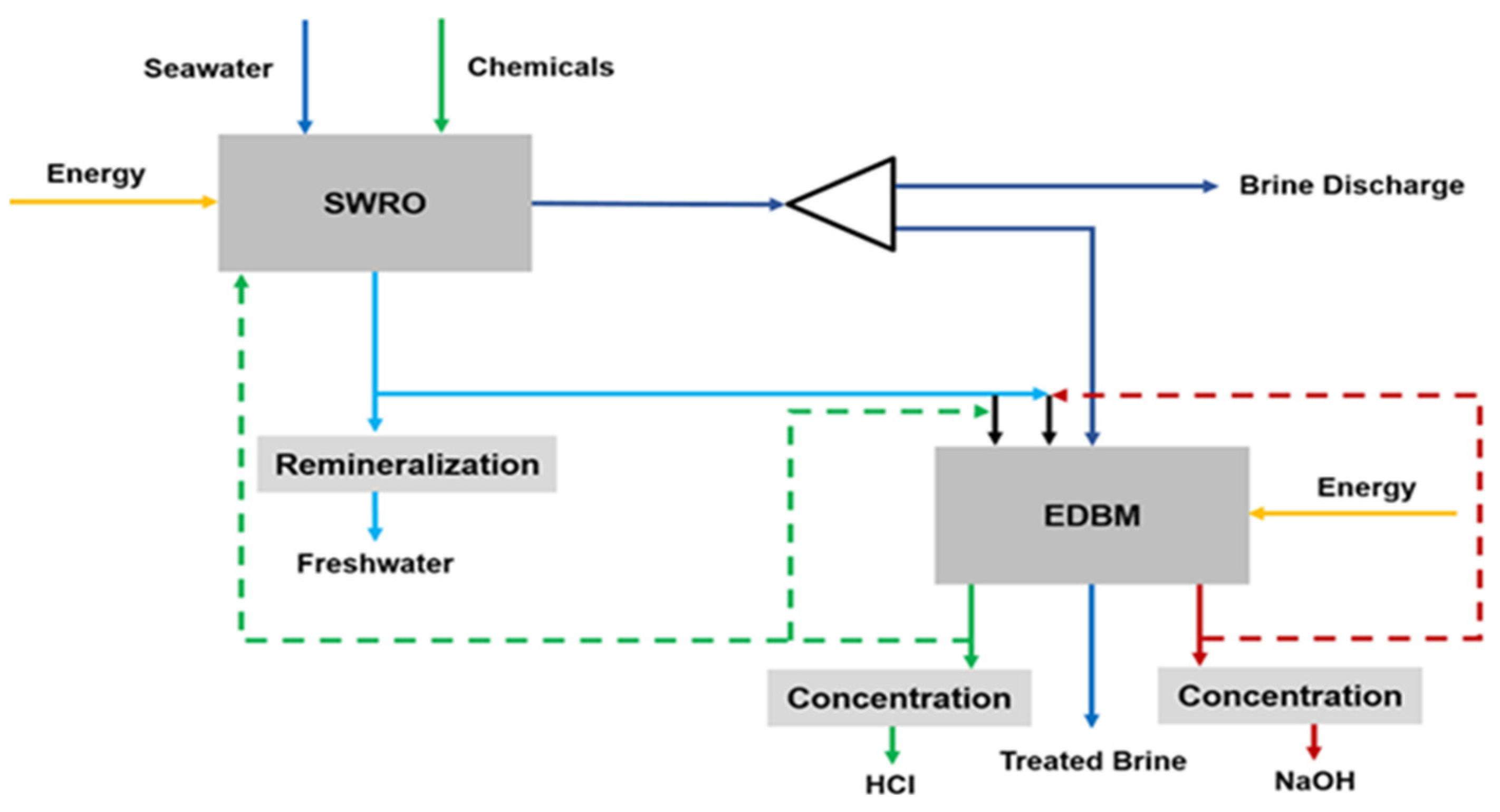
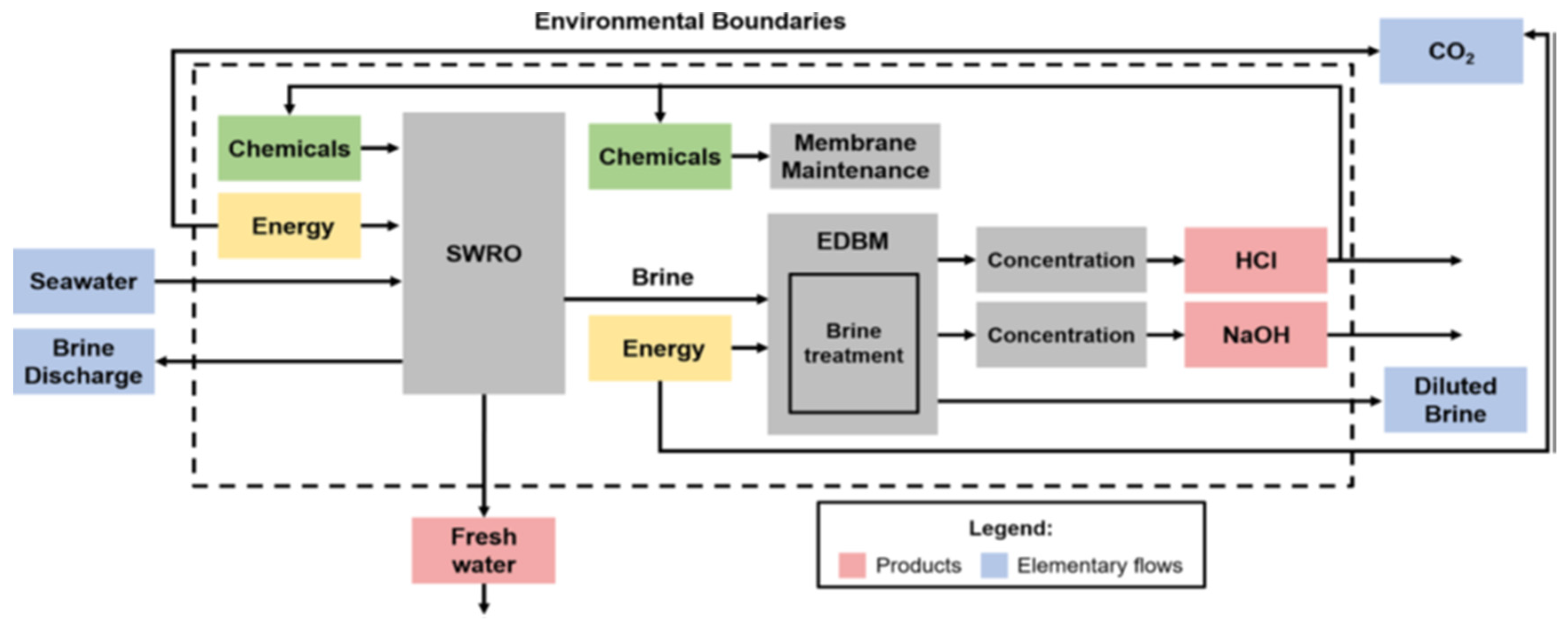
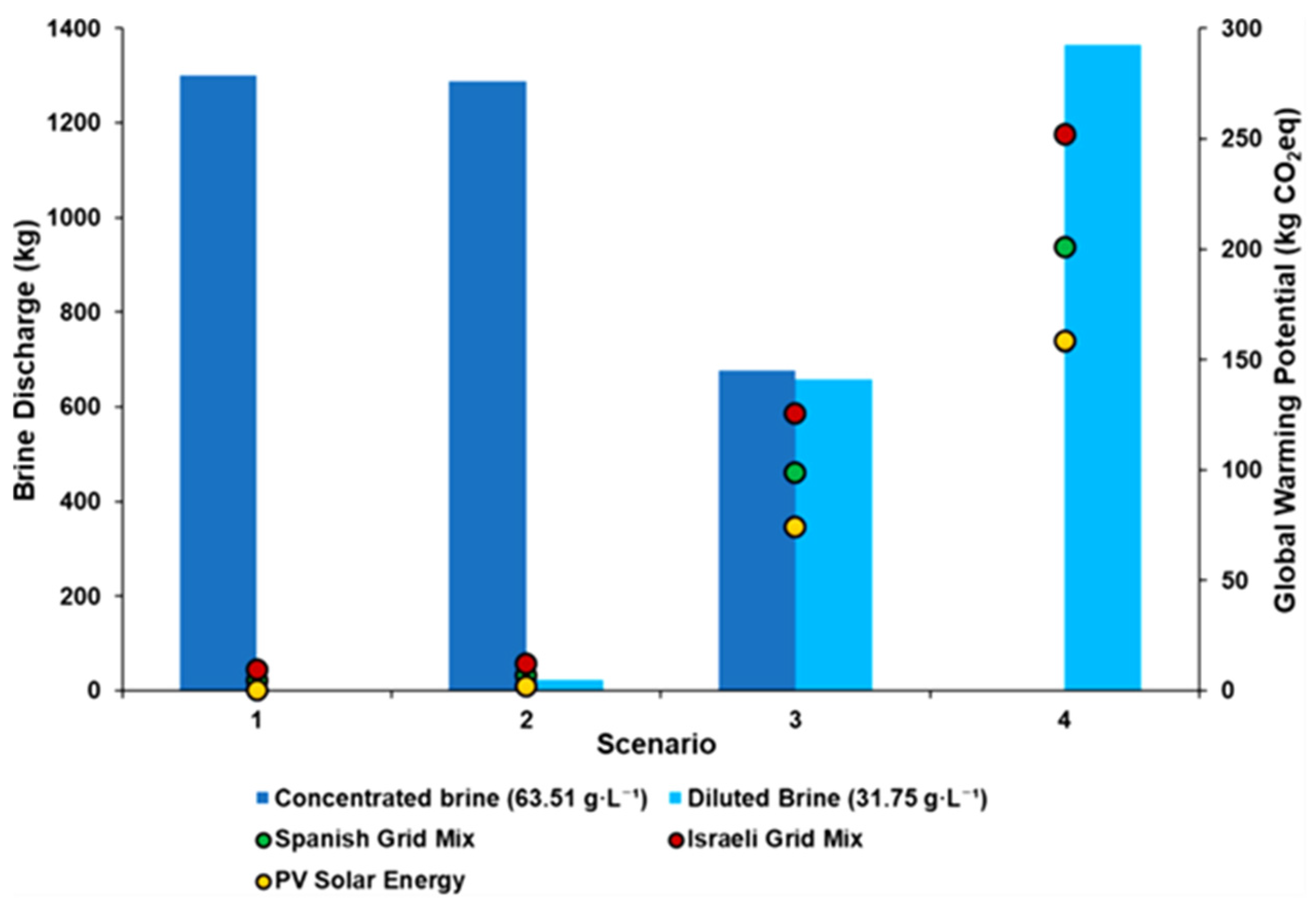
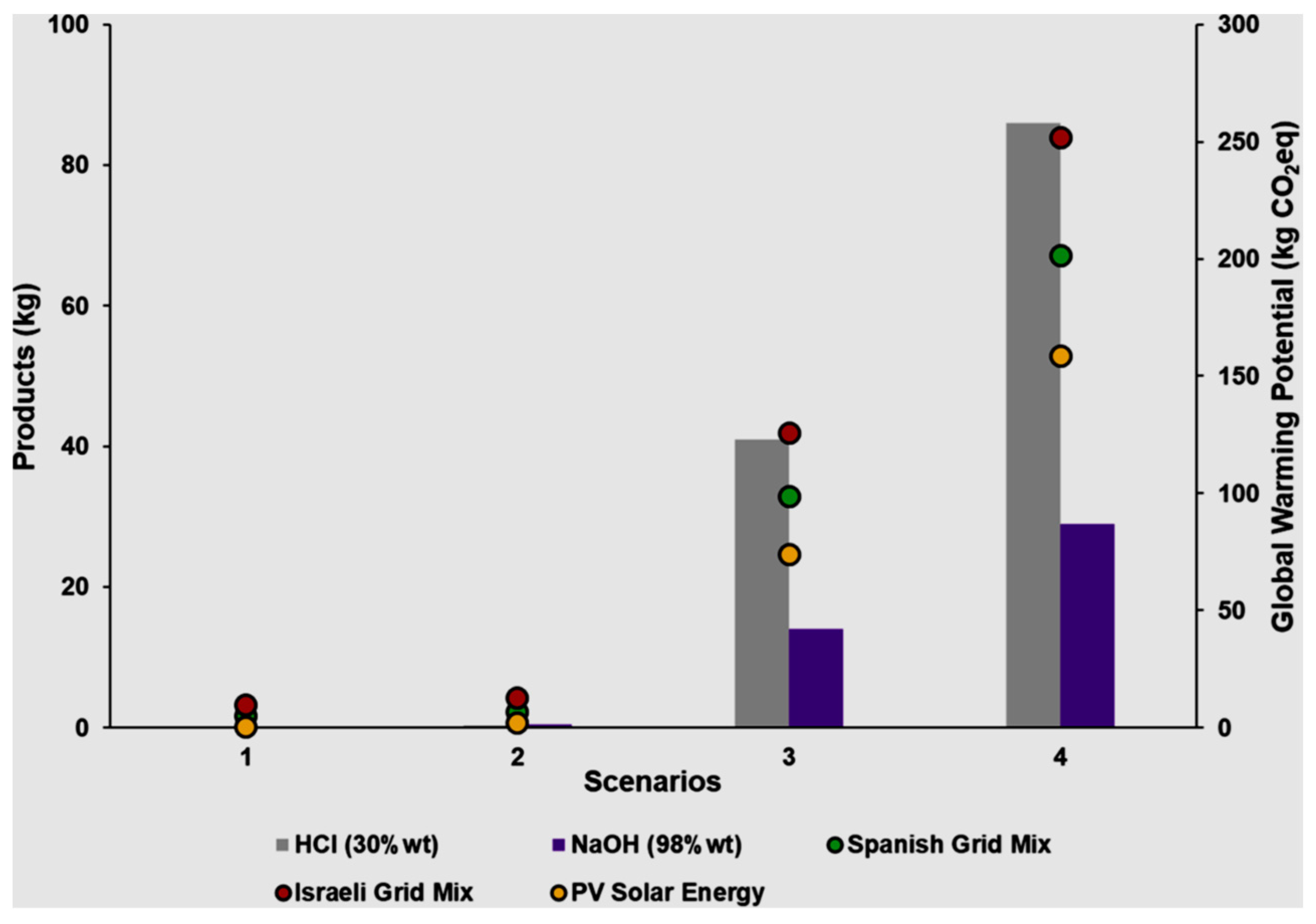
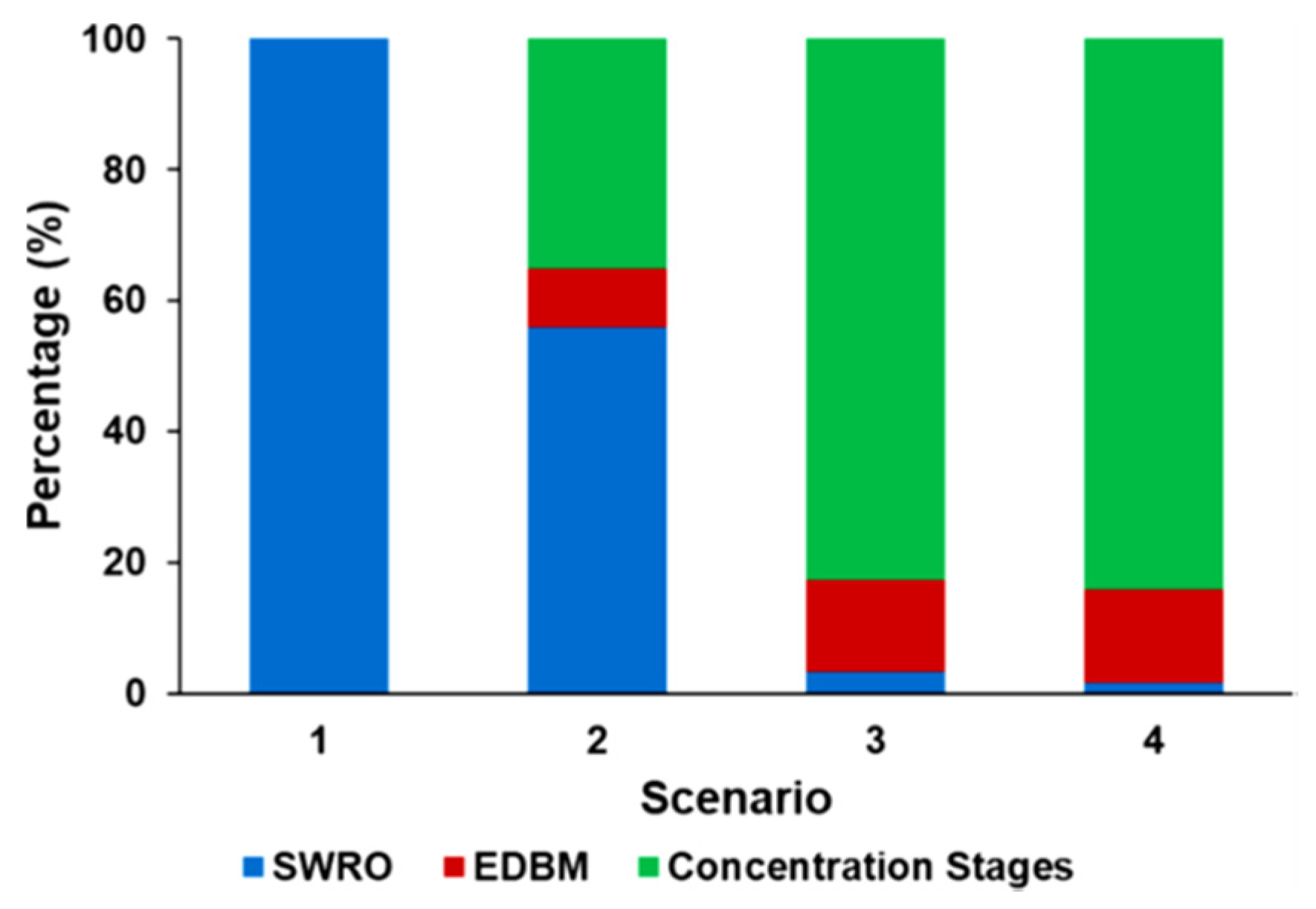
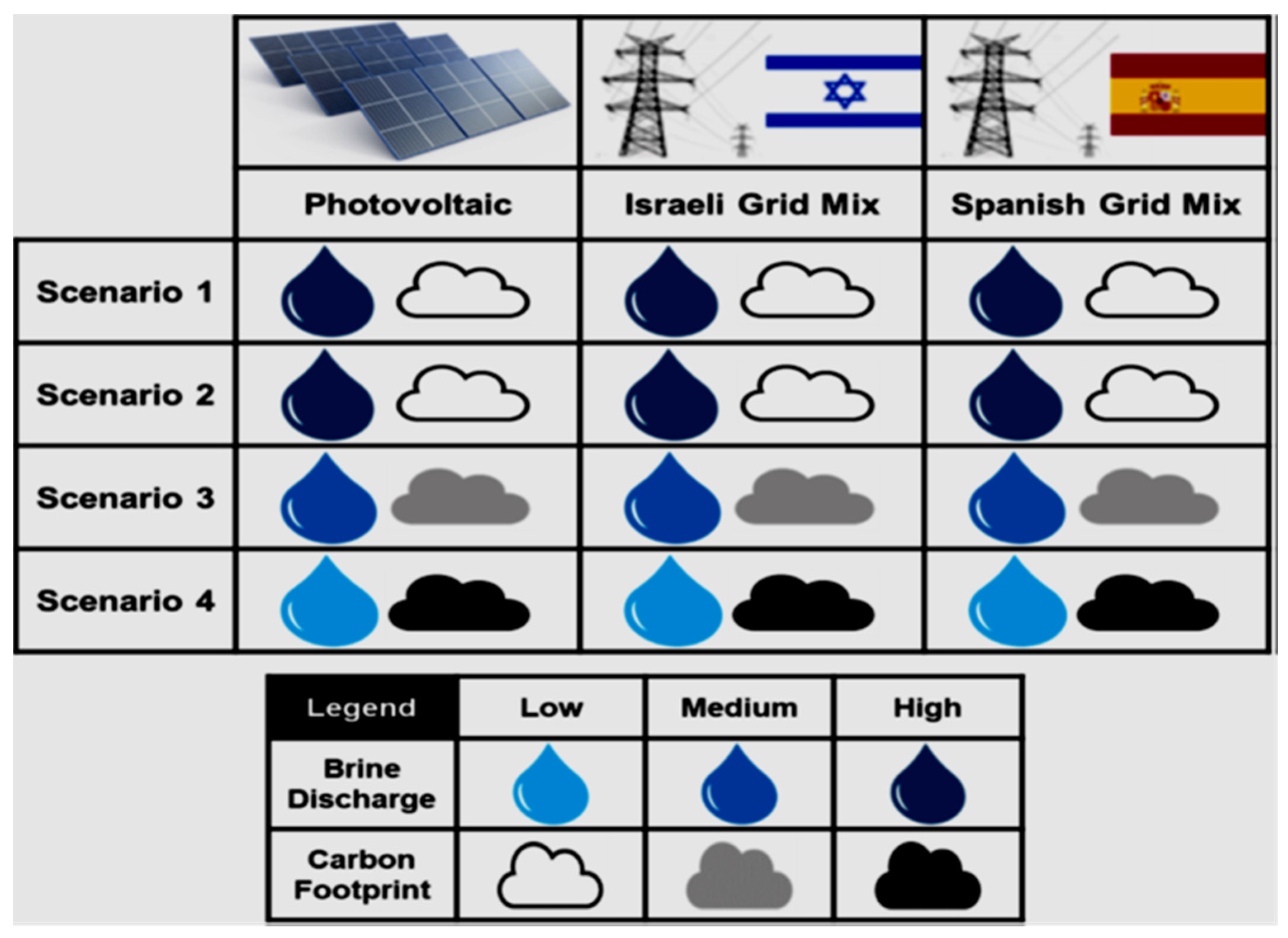
| Indicator(s) | Energy Grid Mix Share [77] | CF—CF (kg CO2 eqv/GJ) | ||||||
|---|---|---|---|---|---|---|---|---|
| Source(s) of Electrical Energy | Spain (%) | Israel (%) | [75] | [76] | [78] | [79] | ||
| Min | Median | Max | ||||||
| Oil | 6.10 | 0.70 | 200.00 | 206.00 | 69.44 | |||
| NG | 18.70 | 51.60 | 150.00 | 113.90 | 136.10 | 180.60 | 136.00 | |
| Coal | 18.70 | 45.80 | 250.00 | 205.60 | 227.80 | 252.80 | 228.00 | |
| Nuclear Energy | 20.40 | 0.00 | 5.00 | 1.00 | 3.30 | 30.60 | 3.00 | |
| Hydro Electric Energy | 11.20 | 0.00 | 5.00 | 0.30 | 6.70 | 611.10 | 7.00 | |
| Biofuel (Biomass) Energy | 1.80 | 0.10 | 200.00 | 172.20 | 205.60 | 247.20 | 206.00 | |
| Waste Sources | 0.50 | 0.00 | 50.00 | |||||
| Geothermal Energy | 0.00 | 0.00 | 10.00 | 1.70 | 10.60 | 21.90 | 11.00 | |
| Solar PV (Photovoltaics) | 2.90 | 1.70 | 10.00 | 5.00 | 13.30 | 50.00 | 13.00 | |
| Solar Thermal Energy | 2.00 | 0.00 | 10.00 | 2.40 | 7.50 | 17.50 | 8.00 | |
| Wind Energy | 17.60 | 0.00 | 5.00 | 1.90 | 3.10 | 15.60 | 3.00 | |
| Tidal Energy | 0.00 | 0.00 | - | |||||
| Other Source(s) | 0.10 | 0.00 | ||||||
| Global CF–CF (kg.CO2-eqv./GJ) | 94.00 | 194.00 | ||||||
| Scenarios | 1st Scenario | 2nd Scenario | 3rd Scenario | 4th Scenario |
|---|---|---|---|---|
| Brine treatment eate (%) | 0.00 | 1.80 | 50.00 | 100.00 |
| BD (to seawater) | 100.00 | 98.20 | 50.00 | 0.00 |
| Self-supply ratio—HCl | 0.00 | 100.00 | 100.00 | 100.00 |
| Products for market (Moossa et al. [10]) | Freshwater supply | Freshwater supply | Freshwater supply, HCl (30.0%wt.), and NaOH (98.0%wt.) | |
| Plant Components | 1st Scenario | 2nd Scenario | 3rd Scenario | 4th Scenario | Units | References |
|---|---|---|---|---|---|---|
| Inputs | ||||||
| Seawater | 2300.00 | 2319.00 | 2399.00 | 2489.00 | kg | Self-Calculated |
| Chemicals (reagents) | ||||||
| HCl | 0.1460 | 0.1460 | 0.1460 | 0.1460 | kg | [61] |
| Power input | ||||||
| SWRO | 13.30 | 13.40 | 13.90 | 14.40 | kWh | [80] |
| EDBM | 0.00 | 2.150 | 60.90 | 126.00 | kWh | [75] |
| Heat energy input | ||||||
| Acid and base concentration stage(s) | 0.00 | 8.38 | 360.0 | 752.0 | kWh | Self-Calculated |
| Process output products | ||||||
| Freshwater | 1000.00 | 1000.00 | 1000.00 | 1000.00 | kg | Self-Calculated |
| HCl (30.0%wt.) | 0.00 | 0.40 | 41.0 | 86.0 | kg | Self-Calculated |
| NaOH (98.0%wt.) | 0.00 | 0.50 | 14.0 | 29.0 | kg | Self-Calculated |
| Waste Product(s) | ||||||
| Concentrated brine (NaCl)conc—63.5 g/L | 1300.00 | 1287.00 | 678.00 | 0.00 | kg | Self-Calculated |
| Post-treated brine (NaCl)—31.80 g/L | 0.00 | 23.00 | 6.580 | 1365.00 | kg | Self-Calculated |
| Unit(s) | Brine Treatment Rate (%) | Concentrated BD (63.510 g/L) [43] | BD Treatment (31.750 g/L) [43] | Total BD [43] | Total BD Mean Concentration (g/L) |
|---|---|---|---|---|---|
| 1st Scenario | 0.00 | 1300.0 | 0.00 | 1300.0 | 63.510 |
| 2nd Scenario | 1.80 | 1287.0 | 23.0 | 1310.0 | 62.950 |
| 3rd Scenario | 50.0 | 678.0 | 658.0 | 1336.0 | 47.870 |
| 4th Scenario | 100.0 | 0.00 | 1365.0 | 1365.0 | 31.750 |
Disclaimer/Publisher’s Note: The statements, opinions and data contained in all publications are solely those of the individual author(s) and contributor(s) and not of MDPI and/or the editor(s). MDPI and/or the editor(s) disclaim responsibility for any injury to people or property resulting from any ideas, methods, instructions or products referred to in the content. |
© 2023 by the author. Licensee MDPI, Basel, Switzerland. This article is an open access article distributed under the terms and conditions of the Creative Commons Attribution (CC BY) license (https://creativecommons.org/licenses/by/4.0/).
Share and Cite
Musharavati, F. RETRACTED: A Study on Life Cycle Impact Assessment of Seawater Desalination Systems: Seawater Reverse Osmosis Integrated with Bipolar-Membrane-Enhanced Electro-Dialysis Process. Sustainability 2023, 15, 16673. https://doi.org/10.3390/su152416673
Musharavati F. RETRACTED: A Study on Life Cycle Impact Assessment of Seawater Desalination Systems: Seawater Reverse Osmosis Integrated with Bipolar-Membrane-Enhanced Electro-Dialysis Process. Sustainability. 2023; 15(24):16673. https://doi.org/10.3390/su152416673
Chicago/Turabian StyleMusharavati, Farayi. 2023. "RETRACTED: A Study on Life Cycle Impact Assessment of Seawater Desalination Systems: Seawater Reverse Osmosis Integrated with Bipolar-Membrane-Enhanced Electro-Dialysis Process" Sustainability 15, no. 24: 16673. https://doi.org/10.3390/su152416673
APA StyleMusharavati, F. (2023). RETRACTED: A Study on Life Cycle Impact Assessment of Seawater Desalination Systems: Seawater Reverse Osmosis Integrated with Bipolar-Membrane-Enhanced Electro-Dialysis Process. Sustainability, 15(24), 16673. https://doi.org/10.3390/su152416673







